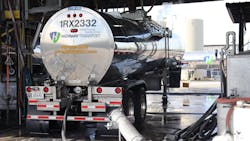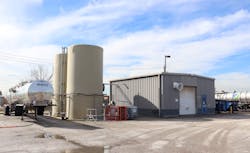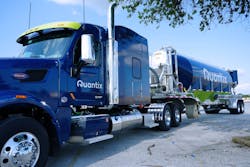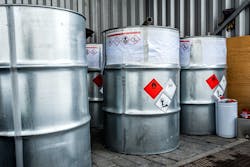Tank cleaning quandary: An essential bulk service confronts existential crises
Tank cleaning has come a long way in the last 40 years.
The equipment is more advanced, the procedures are more refined, and the byproducts are more environmentally friendly. Unfortunately, as recent events in South Carolina and Texas tragically remind us, the job remains hazardous. It also remains an essential service that protects our nation’s food, chemical, and energy supply chains.
“Tank trailers are not disposable,” said Bill McNutt, president of WCM Group, which specializes in environmental permitting and compliance across multiple industries, including tank trailer transportation and cleaning.
“When you deliver a load, you don’t throw the tanker away. You’ve got to clean it.”
Sadly, the task isn’t getting any easier—or more glamorous.
Shippers continue to manufacture new products, each with their own unagreed-upon cleaning requirements; growing government and regulatory scrutiny make operating a tank cleaning facility increasingly complex and cost-ineffective, especially in regard to air permitting and wastewater disposal, suppressing the number of new tank washes coming online, and the materials existing facilities are willing to wash out; antiquated trailer equipment isn’t always easy to clean safely; and good help is hard to find.
“The price of entry into the trailer-cleaning business is immensely higher and more complicated—in terms of dollars and human capital—then it used to be,” McNutt asserted. “It’s evolving to be prohibitive for many companies.”
The good news is people like Doug Vineyard, Highway Transport managing director of equipment services, and National Tank Truck Carriers Tank Cleaning and Maintenance Council chairman; and Jerry Curl, G&D Trucking/Hoffman Transportation director of operations, remain unapologetically passionate about the industry, and steadfastly committed to improving tank cleaning safety, sustainability, and efficiency for all.
“I love what I do,” Vineyard said. “I’ve done it for 31 years. I wouldn’t know how to act doing anything else.”
He may finally have an ally who can help people do it better, too.
Brandon Johnson, who’s president of the Hagen Johnson Group and the International Milk Haulers Association, is developing a system he says unites all cargo tank stakeholders—including tank cleaners, owners, and manufacturers; and shippers, receivers, and regulatory bodies—in food-grade transport and beyond, by forcing collaboration on standardized processes that boost supply chain transparency and consistency.
“It’s going to happen. The government will set the standard if we don’t,” Brandon said.
“So I’d rather have us, the people in the industry, do it first, and help bring forth a way to clean tanks that works for everyone.”
Quality of life
Jeff White, whose family owns White Tank & Truck Repair and Commercial Transport, both headquartered in Belleville, Illinois, is fortunate. He employs a highly tenured tank wash technician, Chris Balster, who takes his role seriously—and understands his worth. “The president of [a shipper customer] came in, and walked through the wash, and [Balster] told him his position was the most important in the company,” White chuckled.
Vineyard agreed, calling tank cleaning “the foundation” for bulk hauling, and tank wash technicians essential workers. “They are the heart of what we do, if you really want to know the truth,” he insisted. “Yes, drivers are important, too, they move the load, but they can’t move it if they don’t have a clean tank to pull.” Tank cleaning is a rewarding career, too. Vineyard and Mike Johnson, National Tank Services (NTS) vice president, started on tank wash floors. Vineyard now oversees seven Highway Transport cleaning facilities, and Mike manages a network of 42 cleaning and repair locations, including 29 wash racks.
“You don’t have to move,” Mike said. “It’s not just an entry-level position anymore.”
Still, finding folks who are eager to enter the industry is a challenge. It’s a difficult, blue-collar occupation, frequently performed in unfriendly conditions, that many people don’t know about. “Today’s workforce is vastly changed compared to when Doug and I came up through the ranks as tank cleaning technicians,” said A-One Chemicals & Equipment’s Ed Wickham, vice-chair of NTTC’s tank cleaning council. Industry is adapting, installing electronics that make facilities safer, and more appealing to today’s technology-enabled prospects. But identifying candidates with the right mindset for a highly specialized task is difficult, so industry leaders say securing a Tank Cleaner of the Year award—like NTTC’s Tank Truck Driver of the Year honor—a skill-labor designation, and more trade-school training are critical going forward.
Chris Ball, CEO of Quantix, which boasts 22 dry bulk tank washes, agrees, saying education is the foundation of tank cleaning safety, and quality. But execution requires adept supervision, which often is lacking at outside washes, he contends, prompting Quantix to hire quality control personnel and plan its first dual dry bulk/liquid tank wash in Baton Rouge, Louisiana. “The quality is terrible—and it’s causing service issues,” he said. When tank washes find capable techs, it’s important to have patience, keep them busy, and ensure they’re happy. “You’ve got to take care of them, pay them well, and give them a schedule they like,” Ball said.
Confined-space safety
Tank cleaning is safer and greener than in the 1980s, industry insists. “There is more attention by everyone cleaning tanks to safety and the environment, so it’s evolved,” McNutt said. “It still has a ways to go, but it’s a factor of 100 better than it was 40 years ago.” Recent events offer sobering reminders of the job’s inherent dangers. Two techs suffered hydrogen sulfide exposure at a tank wash in October 2023 in Beaumont, Texas, and a man died after a chemical incident at a tank service facility in January in Spartanburg, South Carolina.
Tank cleaning facilities are adopting technologies that better protect their employees, including automated valves and spinners, and cameras for shop floors and cargo tank interiors. NTS is capturing images of clean trailers on tablets and evaluating a video system for post-wash inspections in hopes of abating confined-space entries. “It is a camera technology that checks the tank’s cleanliness from outside the vessel, so the need to go inside the tank is reduced, because that’s one of the industry’s biggest risks,” Mike said.
Entering a tank still is the best way to check its cleanliness today, Wickham cautioned, but video technology is advancing rapidly. NTS shops already inspect fuel trailers for cracks using cameras pushed through the flush nipples, Mike said. “As this technology comes along and gets better, opinions will change,” he insisted.
“If I can eliminate 99% of my tank entries, I keep my workers safer.”
Safety-conscious tank wash operators like White take further steps to reduce risk, including removing loading tubes for easier cleaning, and working with OEMs to specify access points that keep employees on the ground. “Those are the big pushes we’ve been trying to make over the last several years,” he explained.
Air permitting
Finding and protecting workers aren’t the only tank wash challenges. Air permitting is evolving into a “big” issue with the U.S. Environmental Protection Agency (EPA), McNutt said, local governments continue to tighten wastewater thresholds—with more regulation looming—and trailer equipment isn’t always optimized for cleaning.
Tank wash registration and permitting varies at the federal and state levels, and from municipality to municipality, McNutt said, making navigating the regulatory landscape laborious. “They all have different programs, so it’s a challenge, and if you don’t speak the language, it’s tough to get anything done expeditiously,” he maintained. Or at all. In Texas, for instance, operators need only show they’re installing the “best available control technology” for the volatile organic compound (VOC) emissions released during cleaning, but a few Texas cities no longer issue any permits for washing transportation equipment, Wickham said.
EPA Region 5, which includes Illinois, Indiana, Michigan, Minnesota, Ohio, and Wisconsin, now is scrutinizing VOC emissions at tank washes, added Donny Hearn, WCM executive vice president. “We have several clients who’ve had inspections, and they were asked for data on what they’re doing and how they’re doing it,” he said. Vapor abatement includes flares, thermal oxidizers, and carbon absorption, but agencies estimate emissions differently, and capital and maintenance costs hinge on system selection.
Wastewater disposal
NTS is upgrading vapor collection and monitoring, and wastewater treatment capabilities—improvements that include increasing storage capacity, allotting more time for solids to settle, and adding dewatering boxes and BTEX air-stripping towers—but its wastewater-stream expenses still are up 38% year-over-year, Mike revealed. “The jurisdictions are tightening their pollutant limits, which drives our sewer surcharges up,” he said.
“Even with capital injections to improve our systems, we still see costs increasing.”
Hearn isn’t surprised. State and federal regulators are tightening limits, forcing municipalities to follow suit, and the associated costs “move upstream” to WCM clients, he said. “As analytical methods improve and detection levels lower, those things become the highlight, and now we’re looking for parts per trillion—which is a flake off a gnat’s eyelash of material in wastewater, and quite frankly, once it’s there it’s hard to remove,” he said.
WCM is seeing growing sensitivity to per- and polyfluorinated substances, or PFAS, which is in fire-fighting foam, and filled the wastewater trucked from Ohio to Texas Molecular in Deer Park, Texas, after the East Palestine train derailment. “If I can’t discharge it to my POTW [publicly owned treatment works] I have to truck it somewhere as a waste, to have it incinerated or deep-welled, driving the cost up dramatically,” Hearn said. Insurers also are starting to ask questions about PFAS, so cautious tank washes refuse it, he advised.
Equipment is evolving to meet new limits—when companies can afford it. “You’re going to pay a significant amount of non-revenue-generating money to clean a trailer, which causes some people to reconsider,” Wickham said. However, current technology can address most challenges, with an extra step or two, if facilities go “back to basics” on residual control. “Sometimes, if they simply refocus their efforts, they can maintain compliance,” he said.
And a select few shippers are starting to take back heel, Johnson said.
“As their waste disposal expenses go up, they’re going to start seeing that as an effective cost-saving measure, too,” he predicted.
Regulatory burden
The Occupational Safety and Health Administration (OSHA) is scrutinizing tank-cleaning operations across 11 states as part of its Regional Emphasis Programs (REPs) in Regions V and VI that go through July 2026 and July 2024, respectively, and are renewable. “It has certainly kept everybody on their toes,” Wickham acknowledged. But the REPs also give OSHA license to enter facilities and look for other issues, and the agency has emphasized enforcement over education, leaders lamented. “There is a help piece, but we haven’t been able to get together as an industry, with OSHA, to realize it,” Wickham said. “There’s still a gap there.”
Additionally, EPA recently issued an Advance Notice of Proposed Rulemaking for used drum management and reconditioning that promises to “put a kibosh in the supply chain” if it leads to tank washes requiring Resource Conservation and Recovery Act (RCRA) treatment, storage, and disposal (TRD) permits, which “take years” to obtain, Hearn said. “That’s a significant potential change in how tank trucks manage residue left inside a tank after coming back from unloading product,” McNutt confirmed. And the January 2026 compliance date for the Food and Drug Administration’s Food Traceability final rule is fast approaching.
“All the entities are coming at you,” said Curl, pointing out the Pipeline and Hazardous Materials Safety Administration (PHMSA) and Federal Motor Carrier Safety Administration (FMCSA) also regulate haulers of hazardous materials.
Growing complexity led NTS to hire an industrial hygienist. It’s also forcing facilities to adopt a “significant amount of technology to achieve compliance,” Wickham said, and carriers to tackle third-party business to cover expenses. “The rules will continue to be more of a challenge, which is going to force more tank washes to have enough size and throughput to absorb additional costs, or go out of business,” Brandon said.
Dry bulk equipment
Cleaning out certain dry bulk products like flour, which acts like concrete when its wet, comes with unique complications shippers, tank trailer manufacturers, and equipment suppliers frequently fail to fathom, White argued. Increasingly common “conversion” washes, which prep trailers to haul dissimilar products, are particularly cumbersome because they involve removing all components, like aerators, gaskets, valves, and tubes. “Flour trailers weren’t built with [disassembly] in mind,” White said. “So I’ve got valves that haven’t been off in years … and the bolts are stuck. We’ve broken several flanges, so then we have to take the tank to our welding shop, and a wash that was scheduled for two hours now is a major repair.”
White said he wonders if OEM consolidation is diminishing construction knowledge. “I have trailers classified as ‘edible trailers,’ but when I get them into my shop, I have to redo the loading pipes because they’re welded on, or aren’t within reach of a manhole, and they’ve got U-bolts with black nylon sleeves,” he said. “You can’t do that.”
Quantix went to full conversion washes for its pneumatics two years ago in a move that reduced contaminants to “zero,” Ball said. But the process is tedious, so Quantix passes incremental costs to shippers, and denies claims from those who refuse to accept them. “We haven’t had much pushback from customers because they know a contamination problem can cost $300,000 or more,” he maintained.
Standard transparency
Further complicating matters, industry constituents aren’t in consensus on cleaning requirements, the definition of a “clean, dry, odor free” trailer, or even the terminology tank washes use from one company to the next. “We’re operating in an industry where there are no standards,” Curl said. “If I go to 30 different places, I’ll find 30 different requirements, I guarantee.” And meeting just a few is a considerable challenge, forcing White to eschew incompatible products. “It’s becoming incredibly difficult to operate with two or three shipper’s requirements because they’re all coming up with different standards,” he said.
That’s why Curl, and a growing cadre of cargo tank stakeholders, believe in “Vessey,” a blockchain technology that digitally documents the life of a vessel used to transfer bulk products with immutable records accessed by any device. The system includes a QR code permanently affixed to the trailer, and a “go/no-go” loading gauge that assesses a tank’s compatibility based on insurance coverage, current certifications, and configuration. “The system specifically deals with tanks,” Brandon said. “There’s no other program or place that addresses or ensures vessels are cleaned properly. Vessey provides the platform for that.”
Cedar Grove Cheese in Plain, Wisconsin, piloted the system last year; and Foremost Farms and The University of Wisconsin-Madison started a test in January. Now Brandon is looking for “larger” entities to participate in Vessey’s development, while also seeking additional funding and developing a viable business model.
“It’s a good avenue to go down,” Curl concluded. “This is exactly what our industry needs.”
About the Author
Jason McDaniel
Jason McDaniel, based in the Houston TX area, has more than 20 years of experience as an award-winning journalist. He spent 15 writing and editing for daily newspapers, including the Houston Chronicle, and began covering the commercial vehicle industry in 2018. He was named editor of Bulk Transporter and Refrigerated Transporter magazines in July 2020.





